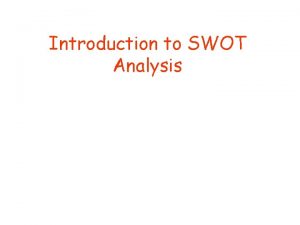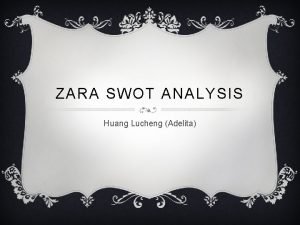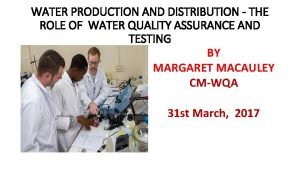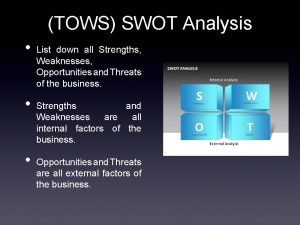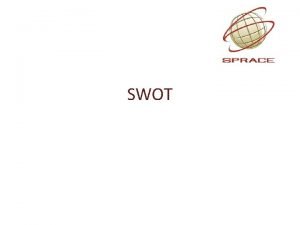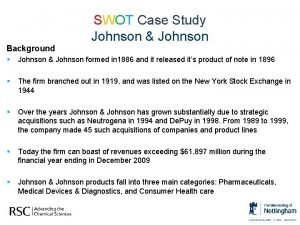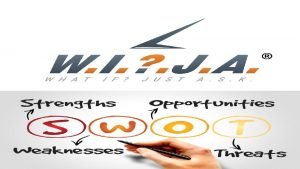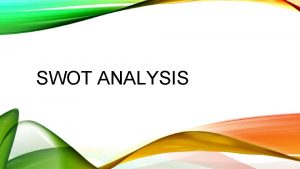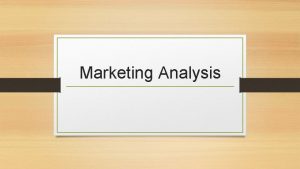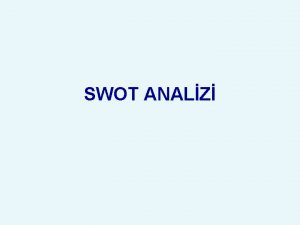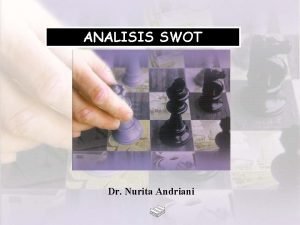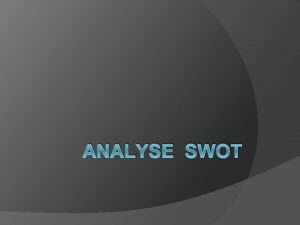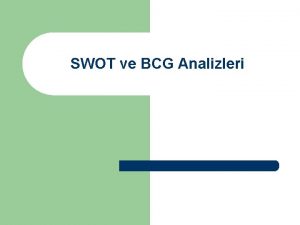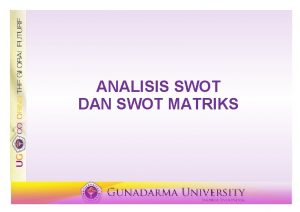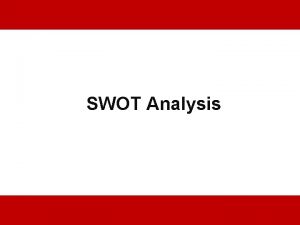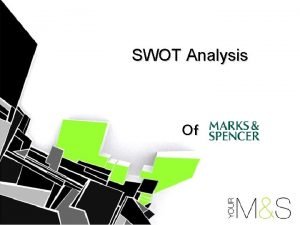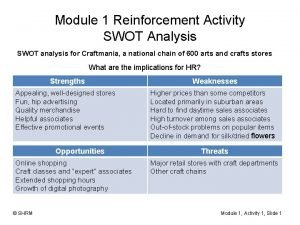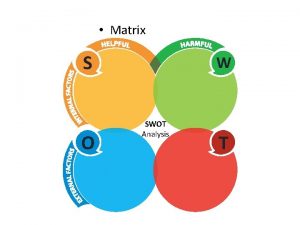Introduction to SWOT Analysis What is SWOT It
















- Slides: 16

Introduction to SWOT Analysis

What is SWOT? • It is a planning tool used to identify Strengths, Weaknesses, Opportunities and Threats involved in a business. It is used as part of Strategic Planning Process

Strategic Planning helps an organisation to answer some basic and critical questions like: a) Where we stand? b) What is our goal? c) How to reach the desired goal? d) How to evaluate performance?

The Environment The actions of an organisation /institution are influenced simultaneously by two factors: a) Internal Environment: People, systems, infrastructure, capabilities, culture etc. b) External Environment: Political, legal, social, economical, technological etc.

Internal Environment Analysis of Internal Environment leads to identification of: a) Strengths: Positive aspects which are within the control of the institution. b) Weaknesses: Constraining factors that hinder the institution’s ability to achieve its desired goals.

Strengths & Weaknesses Contributing Factors: • People (Teachers/Staff/Students) • Programmes (UG/PG/Doctoral) • Properties (Assets/Infrastructure/Lab) • Processes (Teaching/Research)

Strengths • • Highly competent faculty with Ph. D. Modern laboratories & equipments Unique programmes offered Value adding additional programmes Reputation & brand image Examination & Evaluation Process Research projects/Consultancy Industry interactions

Weaknesses • • Lack of competent/qualified staff Inadequate facilities/labs Outdated syllabus/courses Lack of industry orientation Weak employability of students Lack of research activities Internal Funding difficulties for projects

External Environment Analysis of External Environment leads to identification of: a) Opportunities: Attractive factors that help an institution to develop & improve b) Threats: Factors beyond the control of an institution that potentially damage the present existence and future development

Opportunities & Threats Contributing Factors: • Technological • Economic • Legal/Regulatory • Social • Demographic • Political

Opportunities • Growing demand for various courses • Growing demand for Technically qualified people • New Technology Developments • Research opportunities in specialised and niche areas • Collaborations with industry • Collaborations with institutes of higher learning (national & international)

Threats • Competition from new entrants at local, national & international level • Decreasing scope for some programmes • Change in Technology • Declining availability of qualified faculty • Decline in the overall quality of student intake • Tight regulatory measures

• • Why SWOT? Strengths – How to leverage? Weaknesses – How to overcome? Opportunities – How to exploit? Threats – How to defend? SWOT provides clarity on where we stand & in which direction we should move SWOT leads to development of shortterm & long-term objectives.

In the Absence • • Hidden strengths not utilised Weaknesses not identified & taken care Opportunities missed Unprepared to face threats

After SWOT • Link strengths to action plan to create sustainable competitive advantage • Propose specific action plan to overcome weaknesses • Develop action plan to take advantage of opportunities • Develop action plan to defend the threats

How to proceed? • • Select a coordinator Create a SWOT Team Brainstorm (all stakeholders) Record all suggestions Consolidate ideas Clarify ideas & prioritise Summarise into a SWOT Document • Questionnaire circulated
 Introduction of swot analysis
Introduction of swot analysis Swot analysis introduction
Swot analysis introduction Swot analysis of hr department
Swot analysis of hr department Zara swot analizi
Zara swot analizi Swot analysis for whole foods
Swot analysis for whole foods Lenovo mission and vision
Lenovo mission and vision Swot analysis for procurement department
Swot analysis for procurement department Swot analysis of goldilocks
Swot analysis of goldilocks Tows analysis
Tows analysis Chanel strengths
Chanel strengths 全家 slogan
全家 slogan Eirplay
Eirplay Swot analysis of a teacher
Swot analysis of a teacher Tsmc swot analysis
Tsmc swot analysis Swot manpower
Swot manpower Swot johnson and johnson
Swot johnson and johnson Cos swot analysis
Cos swot analysis
